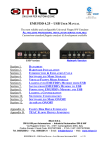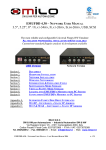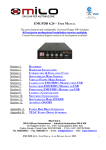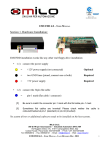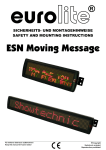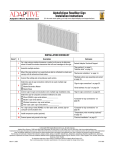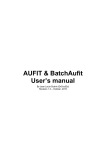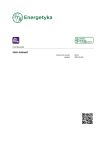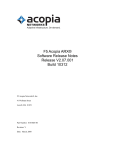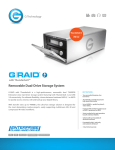Download EMUFDD 4.30 – USB USER MANUAL 3.5", 5.25", 8" / FLAT
Transcript
EMUFDD 4.30 – USB USER MANUAL 3.5", 5.25", 8" / FLAT-34PIN, FLAT-26PIN, SLIM-26PIN, USB, SCSI The most reliable and configurable Universal Floppy HW Emulator ALL-INCLUSIVE PROFESSIONAL INSTALLATION SERVICE AVAILABLE Custom/non-standard floppies analysis & development available USB Version Network Version Section 1. Section 2. Section 3. Section 4. Section 5. Section 6. Section 7. Section 8. Section 9. Section 10. Section 11. DATASHEET HARDWARE INSTALLATION INTRODUCTION & EMULATION CYCLE SOFTWARELESS MODE STORAGE VIRTUAL-FLOPPY MODE STORAGE LOADING INTO EMUFDD'S MEMORY FROM USB SAVING FROM EMUFDD'S MEMORY TO USB FORMATTING EMUFDD'S MEMORY AND USB LOADING A CONFIGURATION SWITCHING CONFIGURATION SOFTWARELESS MODE ON/OFF Appendix A. SUPPORTED FLOPPY DISK DRIVE INTERFACES MILO S.N.C. SW & HW per Automazione - Industrial Automation SW & HW Via Ruggiero Grieco 1/C, 41011 Campogalliano (MO), Italy Codice Fiscale / Fiscal Code: 03373570369 - P.IVA / VAT: 03373570369 Tel. 059/528512 - Fax. 059/520131 - Email: [email protected] - Web: www.milosrl.it EMUFDD 4.30 – USB USER MANUAL - LAST REVISION MARCH 2014 P. 1/25 Section 1. DATASHEET Retrofit services for the industry, from the machinery to the solution EMUFDD Tech-Homepage : www.embeddedsw.net Designer & Customer Support : [email protected] EMUFDD scores a unique 100% rate of successful floppy replacements: • we freely help customers, before purchasing, in collecting all the needed infos; • we provide floppy analysis service to identify/backup/emulate all floppy disks; • we provide free software capable of doing universal backup of floppy disks; • we provide free software capable of full floppy drive virtualization. ALL-INCLUSIVE PROFESSIONAL INSTALLATION SERVICE AVAILABLE We're able to come to you and directly retrofit all kind of existing industrial machinery, quickly, safely and at an affordable price: • no need to change the CNC/PNC/control; • no need to change any electronic; • backup/digitalization/testing of all kind of data/program floppy disks; • backup/digitalization/testing of all system/boot/recovery floppy disks; • absolutely no need to rewrite programs; • new programs saved directly on EMUFDD; • shortest production stopping time; • EMUFDD training of the worker. DIMENSIONS HEIGHT [H] 1'' = WIDTH [W] 4'' = 10,2 cm DEPTH [D] 5,3'' = 13,5 cm WEIGHT EMUFDD 4.30 – USB USER MANUAL - LAST REVISION MARCH 2014 2,5 cm 300 g P. 2/25 HARDWARE 1.5 MB FRAM non-volatile memory INTERNAL MEMORY TYPE INTERNAL MEMORY RELIABILITY 1014 R/W cycles = 438.000 h = 50 years 24/7 POWER ON TIME USER FRONT INTERFACE FLOPPY REAR INTERFACE Less than (<) 500 ms USB keys with FAT format – 100 floppy disks Ethernet 10T network – unlimited floppy disks 34 pin flat cable (3.5'' & 5.25'') + 5V power supply 26 pin flat cable (integrated power supply) 26 pin slim cable (integrated power supply) USB 1.0 standard external floppy SCSI 50 pin standard floppy SOFTWARE FIRMWARE RELEASE Revision 30 (March 2014) CONFIGURATION 100% Jumperfree / Plug'n'Play FIRMWARE UPGRADE SUPPORT NETWORK SOFTWARE Yes WinXP, Win7, Win8, WinServer, x32 & x64 ENCODING FM / MFM / custom on request SPEED 300 rpm / 360 rpm / custom on request DATA CLOCK From 125 Khz (the old 8”) up to 500 Khz (the modern 3.5”) SUPPORT Softwareless Mode: FAT12 – 360KB / 720KB / 1.200MB / 1.440MB Raw Image Mode: Any existing standard or custom on request SOME COMMON 80/2/18x512 – MFM: 500 KHz – 300 rpm – 1.440MB 80/2/15x512 – MFM: 500 KHz – 360 rpm – 1.200MB EXAMPLES... 80/2/9x512 – MFM: 250 KHz – 300 rpm – 720KB 40/2/9x512 – MFM: 250 KHz – 300 rpm – 360KB MORE LESS COMMON EXAMPLES... OLD & RARE EXAMPLES... 83/2/18x512 – MFM: 500 KHz – 300 rpm – 1.494MB 80/2/32x256 – MFM: 500 KHz – 300 rpm – 1.280MB 80/2/5x1024 – MFM: 250 KHz – 300 rpm – 800KB 80/2/18x256 – MFM: 250 KHz – 300 rpm – 720KB 80/2/16x256 – MFM: 250 KHz – 300 rpm – 640KB 80/2/5x1024 – FM: 250 KHz – 300 rpm – 800KB 80/2/18x256 – FM: 250 KHz – 300 rpm – 720KB 80/2/32x128 – FM: 250 KHz – 300 rpm – 640KB 80/2/16x128 – FM: 125 KHz – 300 rpm – 320KB NEED MORE? Ask customer support for help in identifying your floppy disk! EMUFDD 4.30 – USB USER MANUAL - LAST REVISION MARCH 2014 P. 3/25 “Is EMUFDD compatible with my machinery?” “Yes, because EMUFDD it's the best existing professional emulation product, not just another off-the-shelf/junk/chinese one. We will: • provide you extensive pre-selling support and specifically analyze your target; • configure a 100% custom EMUFDD solution, just for you; • help you remotely during the installation, using live Skype connection.” Gallery of custom EMUFDD installations worldwide EMUFDD 4.30 – USB USER MANUAL - LAST REVISION MARCH 2014 P. 4/25 Section 2. HARDWARE INSTALLATION EMUFDD installation works like any other real floppy drive installation: • 2.1) connect the power supply; = +12V power supply (not connected) Optional = two GND lines (joined, connect one or both) Required = +5V power supply Required • 2.2) connect the 34pin flat cable. = pin-1 mark (flat cable / connector) No system driver or additional software needs to be installed on the host system. Be sure to match the connector pin-1 mark with the flat cable pin–1 mark ! Sometimes flat cables are inverted. Please check whether the cable is coloured/marked at pin-1 (standard) or pin-34 (inverted) ! EMUFDD 4.30 – USB USER MANUAL - LAST REVISION MARCH 2014 P. 5/25 Section 3. INTRODUCTION & EMULATION CYCLE EMUFDD is equipped with 1.5 MB of internal FRAM non-volatile memory: • • • no need to keep the USB key plugged in; top-quality data storage and memory reliability (1014 read/write cycles); unlimited permanent internal memory (no battery, fully RoHS). More than 50 years of non-stop read/write emulation at full speed. Each EMUFDD can be used by different users with different skills: • normal users can be allowed to load-only floppy disks (playback); • advanced users can have full access to the program floppy disks; • special floppy disks can be permanently write protected; • simplified access available: 1 USB key = 1 floppy disk. Just ask for your version, fully customized for your everyday's usage ! At power-on EMUFDD immediately (less than 500ms) begins its emulation cycle: • the emulation engine waits for reading or writing requests from the host system, and any read/write floppy disk access will turn the ACT_LED on; • the display continuously shows the On-Line sequence: [– ] / [ –] / [NN], where NN is the current floppy disk number, (from 00 to 99). Snapshot of a display On-Line sequence (NN = 01). EMUFDD 4.30 – USB USER MANUAL - LAST REVISION MARCH 2014 P. 6/25 Section 4. SOFTWARELESS MODE STORAGE Data can be loaded/saved into/from EMUFDD's memory using any USB key. No special software or partitioning is needed to access and copy'n'paste all the floppy disks. The softwareless mode, a.k.a. “Translation”, splits all the floppy disks into subdirectories and each “emufddNN” subdirectory (NN from 00 to 99) will be handled as the root of a different floppy disk: USB key X:\emufddNN\dir1\file1.ext X:\emufddNN\dir2\file2.ext X:\emufddNN\file3.ext X:\emufddNN\file4.ext ... ↔ ↔ ↔ ↔ ↔ EMUFDD (floppy NN) A:\dir1\file1.ext A:\dir2\file2.ext A:\file3.ext A:\file4.ext ... The translation feature: • is available for 360 KB, 720 KB, 1.200 MB, 1.440 MB floppy disks; • is available for both loading and saving; • will truncate filenames to 8+3 short form (Longname.ext → longna~1.ext); • can be enabled/disabled at anytime without reconfiguring (SECTION 11). EMUFDD 4.30 – USB USER MANUAL - LAST REVISION MARCH 2014 P. 7/25 [top window] USB key (H:) in the PC server [bottom window] EMUFDD (A:) in the machinery [top window] USB key (H:) in the PC server [bottom window] EMUFDD (A:) in the machinery EMUFDD 4.30 – USB USER MANUAL - LAST REVISION MARCH 2014 P. 8/25 [top window] USB key (H:) in the PC server [bottom window] EMUFDD (A:) in the machinery [top window] USB key (H:) in the PC server [bottom window] EMUFDD (A:) in the machinery EMUFDD 4.30 – USB USER MANUAL - LAST REVISION MARCH 2014 P. 9/25 [top window] USB key (H:) in the PC server [bottom window] EMUFDD (A:) in the machinery A diff between the original disk#00 in the USB key (H:\emufdd00\cpyteca.cmd) and its “translated” version by EMUFDD (A:\cpyteca.cmd) shows that there's no high-level difference in the directory structure and the attributes of each file: Name / Size / Creation time / Modify time / Access time EMUFDD 4.30 – USB USER MANUAL - LAST REVISION MARCH 2014 P. 10/25 Section 5. VIRTUAL-FLOPPY MODE STORAGE Data can be loaded/saved into/from EMUFDD's memory using any USB key. No special software or partitioning is needed to copy'n'paste all the floppy disks. The virtual-floppy mode, a.k.a. “ISO FLOPPY IMAGE FILES”, splits all the floppy disks into image files (mounted on any PC using free software VFD) and each “emufddNN.img” file (NN from 00 to 99) will be handled as the low-level snapshot of a different floppy disk: USB key X:\emufddNN.img ↔ ↔ ↔ EMUFDD (floppy NN) <floppy> track0/side0/sector1 <floppy> track0/side0/sector2 ... Virtual-Floppy image files: • are available for both loading and saving; • are a low-level snapshot of the floppy disk surface; • allow unlimited emulation of any floppy disk (system, bootable, custom, …); • can be directly mounted as virtual floppy drives by free software VFD; • can be directly imported as backups of real floppies by free software OmniFlop; • can be enabled/disabled at anytime without reconfiguring (SECTION 11). EMUFDD 4.30 – USB USER MANUAL - LAST REVISION MARCH 2014 P. 11/25 [top window] USB key (H:) in the PC server [bottom window] EMUFDD (A:) in the machinery [top window] USB key (H:) in the PC server [bottom window] EMUFDD (A:) in the machinery EMUFDD 4.30 – USB USER MANUAL - LAST REVISION MARCH 2014 P. 12/25 [top window] USB key (H:) in the PC server [bottom window] EMUFDD (A:) in the machinery [top window] USB key (H:) + VFD (B:) in the PC server [bottom window] EMUFDD (A:) in the machinery EMUFDD 4.30 – USB USER MANUAL - LAST REVISION MARCH 2014 P. 13/25 [top window] USB key (H:) + VFD (B:) in the PC server [bottom window] EMUFDD (A:) in the machinery A diff between the original disk#00 in the USB key (B:\cpyteca.cmd) and its “translated” version by EMUFDD (A:\cpyteca.cmd) shows that there's no high-level and low-level difference in the directory structure and the attributes of each file: Name / Size / Size on disk / Creation time / Modify time / Access time EMUFDD 4.30 – USB USER MANUAL - LAST REVISION MARCH 2014 P. 14/25 Section 6. LOADING INTO EMUFDD'S MEMORY FROM USB • 6.1) plug the USB key in and go Off-Line: press LOAD; • 6.2) OFF-LINE_LED turns on and the display shows [CH] while checking the USB key for floppy image files (and subdirectories, if translation is on). Should no USB device be plugged in, the displays shows [nd] and EMUFDD switches automatically back to On-Line mode; • 6.3) the display shows the current floppy number. Select the floppy to be loaded changing the current number (short DOWN/UP pressure = –1/+1, long DOWN/UP pressure = fast rewind/forward). Missing floppies are shown as [NN], existing floppies are shown as [N.N.]. Only existing floppies can be loaded, pressing LOAD; • 6.4) the display, while loading, shows [LO] and LOAD_LED / ACT_LED turn on, until loading end. Any loading error immediately stops loading and display shows [Er]. Successful loading ends with display showing again current floppy number and LOAD_LED / ACT_LED turned off; • 6.5) being no button pressed, after 5 seconds, EMUFDD automatically switches back to On-Line mode. Feel free to plug the USB key safely off. EMUFDD 4.30 – USB USER MANUAL - LAST REVISION MARCH 2014 P. 15/25 Plugging the USB key off while loading will not damage the USB key but will force EMUFDD to reset with an inconsistent internal memory ! Loading completely overwrites EMUFDD's internal memory. The previous floppy, if not backed up before, can't be recovered ! CLICK HERE FOR A VIDEO-DEMO: LOADING INTO INTERNAL MEMORY FROM USB Load + Save can be used to create, without using a PC, multiple copies of an existing floppy on the USB key. For example: load NN and save it as NN+1, NN+2, NN+3, … EMUFDD 4.30 – USB USER MANUAL - LAST REVISION MARCH 2014 P. 16/25 Section 7. SAVING FROM EMUFDD'S INTERNAL MEMORY TO USB • 7.1) plug the USB key in and go Off-Line: press SAVE; • 7.2) OFF-LINE_LED turns on and the display shows [CH] while checking the USB key for floppy image files (and subdirectories, if translation is on). Should no USB device be plugged in, the displays shows [nd] and EMUFDD switches automatically back to On-Line mode; • 7.3) the display shows the current floppy number. Select the floppy to be saved changing the current number (short DOWN/UP pressure = –1/+1, long DOWN/UP pressure = fast rewind/forward). Missing floppies are shown as [NN], existing floppyies are shown as [N.N.]. Both missing and existing floppies can be saved, pressing SAVE (missing ones are created, existing ones are overwritten); • 7.4) the display, while saving, shows [SA] and SAVE_LED / ACT_LED turn on, until saving end. Any saving error immediately stops saving and display shows [Er]. Successful saving ends with display showing again current floppy number and SAVE_LED / ACT_LED turned off; • 7.5) being no button pressed, after 5 seconds, EMUFDD automatically switches back to On-Line mode. Feel free to plug the USB key safely off. EMUFDD 4.30 – USB USER MANUAL - LAST REVISION MARCH 2014 P. 17/25 Plugging the USB key off while saving will damage the USB key. Plug the USB key off only after the OFF-LINE_LED (red) turns off ! Saving completely overwrites USB key's destination. The previous floppy, if not backed up before, can't be recovered ! CLICK HERE FOR A VIDEO-DEMO: SAVING FROM INTERNAL MEMORY TO USB Load + Save can be used to create, without using a PC, multiple copies of an existing floppy on the USB key. For example: load NN and save it as NN+1, NN+2, NN+3, … EMUFDD 4.30 – USB USER MANUAL - LAST REVISION MARCH 2014 P. 18/25 Section 8. FORMATTING EMUFDD'S INTERNAL MEMORY AND USB • 8.1) plug the USB key in and go Off-Line: press SAVE; • 8.2) OFF-LINE_LED turns on and the display shows [CH] while checking the USB key for subdirectories (format is allowed only when translation is on). Should no USB device be plugged in, the displays shows [nd] and EMUFDD switches automatically back to On-Line mode; • 8.3) the display shows the current floppy number. Select the floppy to be formatted changing the current number (short DOWN/UP pressure = –1/+1, long DOWN/UP pressure = fast rewind/forward). Missing floppies are shown as [NN], existing floppyies are shown as [N.N.]. Both missing and existing floppies can be formatted pressing SAVE+LOAD (missing ones are created, existing ones are overwritten); • 8.4) the display, while formatting, shows [FO] and SAVE_LED / LOAD_LED / ACT_LED turn on, until formatting end. Any formatting error immediately stops formatting and display shows [Er]. Successful formatting ends with display showing again current floppy number and SAVE_LED / LOAD_LED / ACT_LED turned off; • 8.5) being no button pressed, after 5 seconds, EMUFDD automatically switches back to On-Line mode. Feel free to plug the USB key safely off. EMUFDD 4.30 – USB USER MANUAL - LAST REVISION MARCH 2014 P. 19/25 Plugging the USB key off while formatting will both damage the USB key and force EMUFDD to reset with an inconsistent internal memory. Plug the USB key off only after the OFF-LINE_LED (red) turns off ! Formatting completely overwrites USB key's destination. The previous floppy, if not backed up before, can't be recovered ! Format is allowed only in softwareless mode (when translation is on) Check the supported formats (SECTION 4). EMUFDD 4.30 – USB USER MANUAL - LAST REVISION MARCH 2014 P. 20/25 Section 9. LOADING A CONFIGURATION EMUFDD configuration is plug'n'play and absolutely jumper-free. It's also possible to configure the emulator with up to 100 different configurations and switch, at run-time, between them. The first 10 configurations (c0÷c9) can be loaded with any custom setting, the other 90 configurations (0.0÷9.0) are fixed presets. • 9.1) load a valid “emufdd.cfg” file into a USB key; Configuration files for any machinery/floppy drive/floppy disk will be provided for free, only after purchasing, writing to the customer support (EmbeddedSW, 7/7 direct line with the designer of EMUFDD) at [email protected] • 9.2) plug the USB key in and go Off-Line: press LOAD; • 9.3) the device will auto-reset (all leds blink very fast) and the display, while changing configuration, shows [cc]. Any configuration error immediately stops auto-reset and display shows [Er]; • 9.4) load a valid floppy into memory (SECTION 6) or, if format is supported, format EMUFDD's memory (SECTION 8). EMUFDD 4.30 – USB USER MANUAL - LAST REVISION MARCH 2014 P. 21/25 Section 10. SWITCHING CONFIGURATION • 10.1) with no USB key plugged in press SAVE+DOWN+UP; • 10.2) select the new configuration (NN = c0÷c9, 0.0÷9.0) changing the current number (DOWN/UP pressure = –1/+1). Missing configurations are shown as [cN], existing configurations are shown as [c.N] and [N.N]. Only existing configurations can be loaded, pressing SAVE+LOAD; • 10.3) the device will auto-reset (all leds blink very fast) and the display, while changing configuration, shows [cc]; • 10.4) load a valid floppy into memory (SECTION 6) or, if format is supported, format EMUFDD's memory (SECTION 8). Example 1: Your device needs two (or more) different kinds of floppy disks. Base configuration (c0) is assigned to the boot disk, the following ones (c1/c2/...) are assigned to user programs with different formats (720 KB, 800 KB, 1.440 MB, ...). • device is powered up; • user selects base configuration and loads the boot image; • user selects another configuration and loads/saves user programs. c0 (BOOT) c1 (720 KB) c2 (800 KB) Example 2: You own more different devices and need to use the floppy on only one of them at a time. Each device is assigned a configuration and you buy only 1 EMUFDD. • EMUFDD is connected “on the fly” to device-i; • user selects configuration-i and loads/saves a batch of work; • EMUFDD is disconnected from device-i and user goes on to the next one. EMUFDD 4.30 – USB USER MANUAL - LAST REVISION MARCH 2014 P. 22/25 c0 (DEVICE-0) c1 (DEVICE-1) cN (DEVICE-N) Connecting an EMUFDD “on-the-fly” it's very easy. You only need to modify, on each machinery, the floppy flat and power supply cables with longer ones, coming out from the machinery/control. After this modify, connecting/disconnecting the EMUFDD will be as easy as connecting/disconnecting a USB key and fast, since there's no more need to open the machinery to reach the floppy cables. Here's an example flowchart about a plastic-injection company with three different kinds of machinery, using a single “shared” EMUFDD device. MACHINERY 1 MACHINERY 2 EMUFDD 4.30 – USB USER MANUAL - LAST REVISION MARCH 2014 MACHINERY 3 P. 23/25 Section 11. SOFTWARELESS MODE ON/OFF The softwareless mode translation feature (SECTION 4) can be enabled/disabled at anytime without reconfiguring the device. • 11.1) with no USB key plugged in press SAVE+UP; • 11.2) the current translation configuration is shown as [tN] (N = 0/1 = disabled/enabled). Pressing SAVE+UP again causes the translation configuration to switch; • 11.3) the device will auto-reset (all leds blink very fast) and the display shows the new translation configuration [tN]. EMUFDD 4.30 – USB USER MANUAL - LAST REVISION MARCH 2014 P. 24/25 Appendix A. SUPPORTED FLOPPY DISK DRIVE INTERFACES 34pin 3.5” floppy: Supported 50pin SCSI floppy: Supported 26pin floppy: Supported 26pin slim floppy: Supported 5.25” & 8” floppy: Supported USB 1.0 floppy: Supported The bullet-proof EMUFDD emulation is available on all the known floppy disk drive interfaces, from the oldest ones to the most modern ones. Supported interfaces are emulated with a wide portfolio of solutions: (1) being natively supported; (2) using custom adapters manufactured by us; (3) using industry-strenght standard adapters. EMUFDD 4.30 – USB USER MANUAL - LAST REVISION MARCH 2014 P. 25/25

























